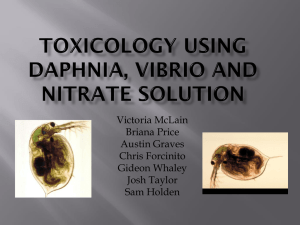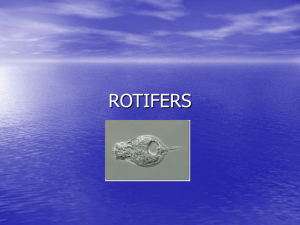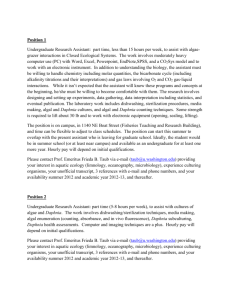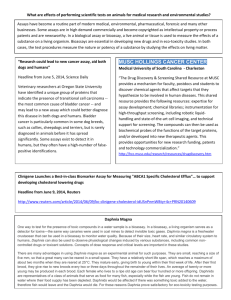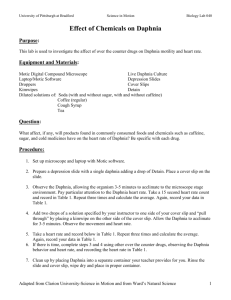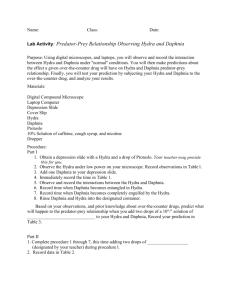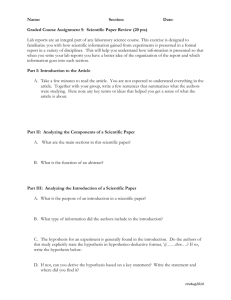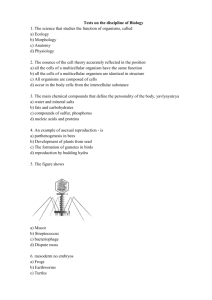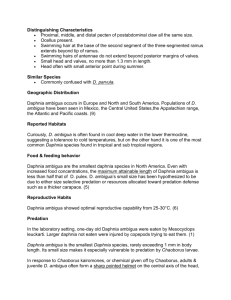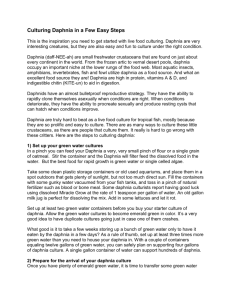Rotifers Rotifers are a group of microscopic animals that live just
advertisement
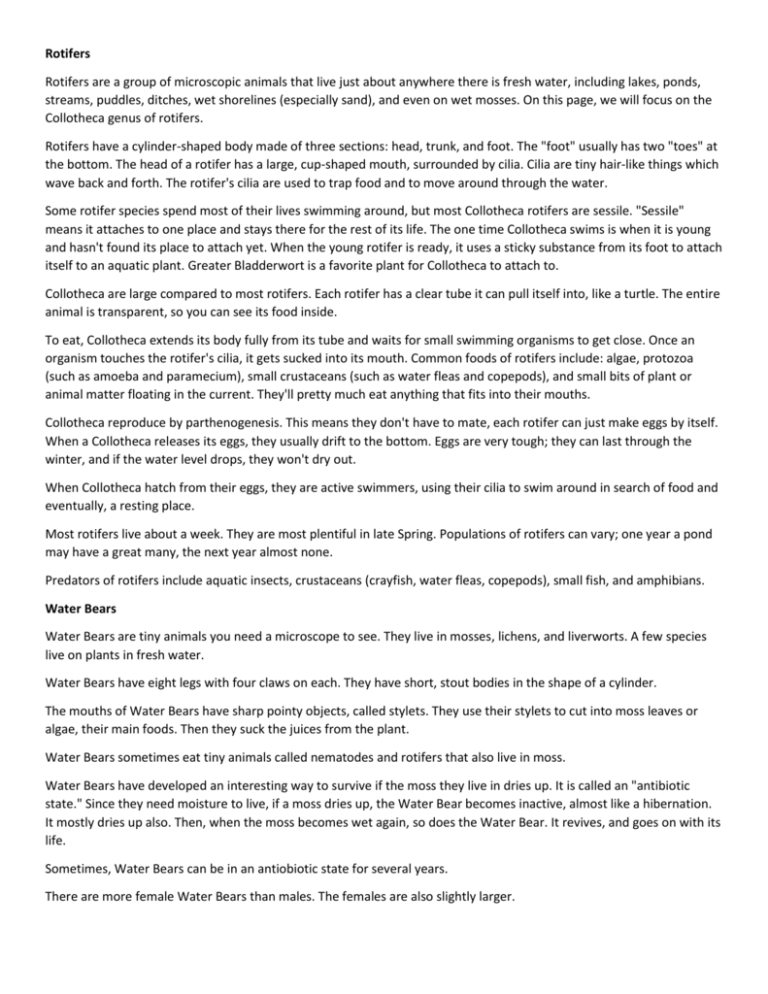
Rotifers Rotifers are a group of microscopic animals that live just about anywhere there is fresh water, including lakes, ponds, streams, puddles, ditches, wet shorelines (especially sand), and even on wet mosses. On this page, we will focus on the Collotheca genus of rotifers. Rotifers have a cylinder-shaped body made of three sections: head, trunk, and foot. The "foot" usually has two "toes" at the bottom. The head of a rotifer has a large, cup-shaped mouth, surrounded by cilia. Cilia are tiny hair-like things which wave back and forth. The rotifer's cilia are used to trap food and to move around through the water. Some rotifer species spend most of their lives swimming around, but most Collotheca rotifers are sessile. "Sessile" means it attaches to one place and stays there for the rest of its life. The one time Collotheca swims is when it is young and hasn't found its place to attach yet. When the young rotifer is ready, it uses a sticky substance from its foot to attach itself to an aquatic plant. Greater Bladderwort is a favorite plant for Collotheca to attach to. Collotheca are large compared to most rotifers. Each rotifer has a clear tube it can pull itself into, like a turtle. The entire animal is transparent, so you can see its food inside. To eat, Collotheca extends its body fully from its tube and waits for small swimming organisms to get close. Once an organism touches the rotifer's cilia, it gets sucked into its mouth. Common foods of rotifers include: algae, protozoa (such as amoeba and paramecium), small crustaceans (such as water fleas and copepods), and small bits of plant or animal matter floating in the current. They'll pretty much eat anything that fits into their mouths. Collotheca reproduce by parthenogenesis. This means they don't have to mate, each rotifer can just make eggs by itself. When a Collotheca releases its eggs, they usually drift to the bottom. Eggs are very tough; they can last through the winter, and if the water level drops, they won't dry out. When Collotheca hatch from their eggs, they are active swimmers, using their cilia to swim around in search of food and eventually, a resting place. Most rotifers live about a week. They are most plentiful in late Spring. Populations of rotifers can vary; one year a pond may have a great many, the next year almost none. Predators of rotifers include aquatic insects, crustaceans (crayfish, water fleas, copepods), small fish, and amphibians. Water Bears Water Bears are tiny animals you need a microscope to see. They live in mosses, lichens, and liverworts. A few species live on plants in fresh water. Water Bears have eight legs with four claws on each. They have short, stout bodies in the shape of a cylinder. The mouths of Water Bears have sharp pointy objects, called stylets. They use their stylets to cut into moss leaves or algae, their main foods. Then they suck the juices from the plant. Water Bears sometimes eat tiny animals called nematodes and rotifers that also live in moss. Water Bears have developed an interesting way to survive if the moss they live in dries up. It is called an "antibiotic state." Since they need moisture to live, if a moss dries up, the Water Bear becomes inactive, almost like a hibernation. It mostly dries up also. Then, when the moss becomes wet again, so does the Water Bear. It revives, and goes on with its life. Sometimes, Water Bears can be in an antiobiotic state for several years. There are more female Water Bears than males. The females are also slightly larger. After mating, females lay eggs in a shed exoskeleton. Water Bears molt (shed their exoskeletons) just like insects and crayfish. Young Water Bears must molt several times before they are adults. Water Bears can be different colors, depending on the species, including gray, bluish, yellowish-brown, reddish, and brown Water Bears are not Arachnids, even though they have eight legs like spiders and ticks. They are also not Nematodes or Crustaceans, even though they have things in common with those groups of animals. Water Bears get their own phylum, called Tardigrada, because they do not fit in with another group of animals. Hydra Hydras are tiny animals, which are closely related to jellyfish. Green Hydras live in fresh water, such as streams, rivers, lakes, and ponds. They are very common. A Green Hydra can grow up to 30 millimeters long, but usually they are less than 15 mm. Green Hydra are found in shallow water, where they attach themselves to plants, stones, twigs, or other objects. Unlike their jellyfish cousins, they don't like to float around. The body of a Green Hydra is long and skinny. Just like jellyfish they have stinging tentacles. One hydra can have anywhere from four to twelve tentacles. Each tentacle has tiny bumps, called nematocysts. The nematocysts release a material that paralyzes another animal. Hydras use their nematocysts to capture prey, and for protection. Green Hydras use a sticky body fluid at their base to attach to an object in a place where there is a lot of food swimming by. Sometimes they attach to the surface of the water and hang down. Prey of Green Hydras include aquatic insects, crustaceans (such as water fleas and scuds), flatworms, aquatic worms, fish fry, and other small creatures in the water. They also eat a certain type of algae, called Chlorella, which is what makes hydras green. Chlorella stays alive inside the hydra. Since algae is a plant, it makes its own food. The hydra lets the Chlorella make food for it. The way Green Hydras reproduce (make more hydras) is by budding. Budding starts with a small bump on a hydra's body. The bump continues to grow until there is a stalk. Next, the new stalk grows tentacles. When it is ready, the new hydra pinches itself off from its parent. The picture above shows a hydra bud forming. To the right is another picture, with two buds on an adult Green Hydra. With the right temperature, and a good food supply, a healthy Green Hydra can make a new bud every three or four days. The population (amount of hydras in one place at one time) is at its greatest in late Spring and early Summer. Predators of hydras include flatworms, crustaceans, and aquatic insects. Sometimes Green Hydras attach themselves to mussel shells. If a hydra needs to move (perhaps it's not getting enough food), it can detach itself and move like an inchworm. Daphnia Daphnia ambigua is the scientific name for a species belonging to a group of animals known as "Water Fleas." Daphnia ambigua is one of the most common Daphnia in our area, although Daphnia are not fleas at all. They are Crustaceans, cousins of crayfish and shrimp. Daphnia live in lakes, ponds, and slow-moving streams. Daphnia ambigua, which is one of the smallest Daphnia, grows up to almost one and a half milimeters. Daphnia ambigua has a spiny, helmet-shaped head, and long antennae. It uses its antennae to swim. By thrusting the antennae downward, the Daphnia pushes itself towards the surface of the water. It pauses after each push and floats back downward. As it drops, the Daphnia breathes and collects food with its ten legs. Daphnia eat algae and protozoans. The way in which Daphnia swim so jerkily is probably how they got the nickname "Water Flea." Daphnia ambigua has a hard outer shell which protects it from some predators. However, even with its tough covering, Daphnia are food for many small fish, tadpoles, salamanders, newts, and aquatic insects. Daphnia are very important because they take nutrients from algae into their bodies and pass those nutrients on to their predators. As other predators eat the fish or other animals which ate the Daphnia, the nutrients get passed on again. This means that Daphnia are an important part of the food chain, even to people, who don't eat Daphnia directly.
